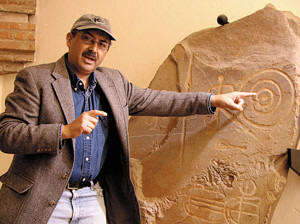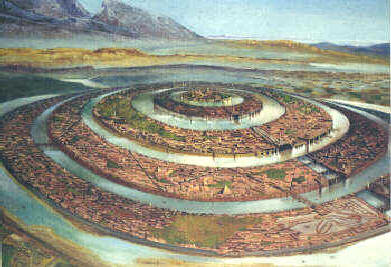Atlantis literally begins with two of Plato's dialogues, Timaeus and Critias. These accounts are the only known written records which refer specifically to a lost civilization called Atlantis. Many people believe the tale to be complete fiction, the creation of a philosopher's imagination used to illustrate an argument. Others believe that the story was inspired by catastrophic events which may have destroyed the Minoan civilization on Crete and Thera. Still others maintain that the story is an accurate representation of a long lost and almost completely forgotten land.It was the Greek philosopher Plato who brought to the world the story of the lost continent of Atlantis.
The story of Atlantis began to unfold with Plato around 355 B.C. Around 370 B.C. Plato said that the continent lay in the Atlantic Ocean beyond the Straits of Gibraltar until its destruction 10,000 years previous.
Plato described Atlantis as alternating rings of sea and land, with a palace in the center 'bull's eye'. [This seems to be a metaphor for the theory of consciousness spiraling around a central source of creation - Sacred Geometry - Phi Ratio.]
Plato used a series of dialogues to express his ideas. In this type of writing, the author's thoughts are explored in a series of arguments and debates between various characters in the story.
A character named Kritias tells an account of Atlantis that has been in his family for generations. According to this

Archaeologist Richard Freund points to symbol of
Atlantis on a stele found in the mud-covered cities pf southern spaon.

character the story was originally told to his ancestor Solon, by a priest during Solon's visit to Egypt.
According to the dialogues, there had been a powerful empire located to the west of the "Pillars of Hercules" (what we now call the Straight of Gibraltar) on an island in the Atlantic Ocean. The nation there had been established by Poseidon, the God of the Sea. Poseidon fathered five sets of twins on the island. The firstborn, Atlas, had the continent and the surrounding ocean named for him. Poseidon divided the land into ten sections, each to be ruled by a son, or his heirs.
The capital city of Atlantis was a marvel of architecture and engineering. The city was composed of a series of concentric walls and canals. At the very center was a hill, and on top of the hill a temple to Poseidon. Inside was a gold statue of the God of the Sea showing him driving six winged horses.
The story goes: around 9000 years before the time of Plato, after the people of Atlantis had become corrupt and greedy, the Gods decided to destroy them. A violent earthquake shook the land, giant waves rolled over the shores, and the island sank into the sea never to be seen again.
At numerous points in the dialogues Plato's characters refer to the story of Atlantis as "genuine history" and that it within "the realm of fact." Plato also seems to put into the story a lot of detail about Atlantis that would be unnecessary for a literary device.
In "Timaeus," Plato described Atlantis as a prosperous nation out to expand its domain: "Now in this island of Atlantis there was a great and wonderful empire which had rule over the whole island and several others, and over parts of the continent," he wrote, "and, furthermore, the men of Atlantis had subjected the parts of Libya within the columns of Heracles as far as Egypt, and of Europe as far as Tyrrhenia."
Plato goes on to tell how the Atlanteans made a grave mistake by
seeking to conquer Greece. They could not withstand the Greeks'
military might, and following their defeat, a natural disaster
sealed their fate. "Timaeus" continues: "But afterwards there
occurred violent earthquakes and floods; and in a single day and
night of misfortune all your warlike men in a body sank into the
earth, and the island of Atlantis in like manner disappeared in the
depths of the sea."
Interestingly, Plato tells a more metaphysical version of the
Atlantis story in "Critias." There he describes the lost continent
as the kingdom of Poseidon, the god of the sea. This Atlantis was a
noble, sophisticated society that reigned in peace for centuries,
until its people became complacent and greedy. Angered by their fall
from grace, Zeus chose to punish them by destroying Atlantis.
By Plato's account, Poseidon, god of the sea, sired five pairs of
male twins with mortal women. Poseidon appointed the eldest of these
sons, Atlas the Titan, ruler of his beautiful island domain. Atlas
became the personification of the mountains or pillars that held up
the sky. Plato described Atlantis as a vast island-continent west of
the Mediterranean, surrounded by the Atlantic Ocean. The Greek word
Atlantis means the island of Atlas, just as the word Atlantic means
the ocean of Atlas.
By Egyptian record, Keftiu was destroyed by the seas in an apocalypse. It seems likely Solon carried legends of Keftiu to Greece, where he passed it to his son and grandson.
Plato recorded and embellished the story from Solon's grandson Critias the Younger. As in many ancient writings, history and myth were indistinguishably intermixed. Plato probably translated "the land of the pillars which held the sky" (Keftiu) into the land of the titan Atlas (who held the sky). Comparison of ancient Egyptian records of Keftiu identifies a number of similarities to Plato's Atlantis. It seems likely that Plato's Atlantis was a retelling (and renaming) of Egypt's Keftiu.
Yet Plato preserved enough detail about the land of Atlantis that its identification now seems very likely., Plato`s dialogues did place the location near the area of Gaderia known as Cadiz today, just pass the pillers of Hercules. The lost city of Tartessos was said to have been there, a city that rsuddenly disppeared in history and brought an end to a great empire.
The cataclysms of 10,000 BC
The Earth saw a major catastrophe in 10,000 BC. That period roughly marks the end of the Last Ice Age, during which time the glaciers melted and consequently water levels rose.
The Egyptian records refer to a great island civilization to the West. Before the melting of the glaciers, there was an island chain that stretched south of Portugal to what is now the Canary Islands. This was the original Atlantis. As they were gradually submerged around 10,000 BC, the civilization rebuilt itself in what is now southwestern Spain.
Archaeological discoveries.
A U.S.-led research team may have finally located the lost city of Atlantis, the legendary metropolis believed swamped by a tsunami thousands of years ago, in mud flats in southern Spain.
"This is the power of tsunamis," head researcher Richard Freund said.
"It is just so hard to understand that it can wipe out 60 miles inland, and that's pretty much what we're talking about," said Freund, a professor at the University of Hartford who led an international team searching for the true site of Atlantis.
To solve the age-old mystery, the team analyzed satellite imagery of a suspected submerged city just north of Cadiz, Spain. There, buried in the vast marshlands of the Dona Ana Park, they believe that they pinpointed the ancient, multiringed dominion known as Atlantis.
The team of archaeologists and geologists in 2009 and 2010 used a combination of deep-ground radar, digital mapping and underwater technology to survey the site.
Freund's discovery in central Spain of a strange series of "memorial cities," built in Atlantis' image by its refugees after the city's likely destruction by a tsunami, gave researchers added proof and confidence, he said.
Atlantean residents who did not die in the tsunami fled inland and built new cities there, he added.